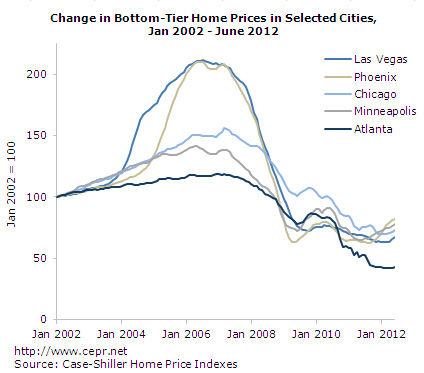August 28, 2012
August 28, 2012 (Housing Market Monitor)
By Dean Baker
Low-end house prices in Phoenix have risen at a 32.4 percent annual rate over the last three months.
The data on the housing market released in August indicate that the recovery is continuing to strengthen. New home sales in July were up 25.3 percent from their year-ago level and tied with May for the highest level since the end of the first-time homebuyers tax credit in April of 2010.
Existing home sales were up 10.4 percent in July from year-ago levels, although they were down somewhat from the levels reached in the winter. It is important to remember that existing homes sales data show actual sales, in contrast to the new home sales that measure the number of contracts signed. Since there is typically a 6-8 week lag between when a contract is signed and the sale is closed, the July data for existing homes still reflect the weakness of the spring that resulted from many purchases being pulled forward by good winter weather. Therefore the strong year-over-year improvement is probably more meaningful than the modest drop in sales from the winter peaks.
The July construction data also showed strength. Housing starts were up 21.5 percent from year-ago levels, while starts of single family homes were up 17.0 percent. Both figures were slight declines from the June levels; however, permits in both categories hit new post-bubble peaks.
The price data in the Case-Shiller 20-City Index again showed rapid appreciation in June, with the index rising by 0.9 percent, after rising 1.0 percent in May. Over the last three months, prices have risen at an 11.3 percent annual rate.
While prices are rising almost everywhere (Charlotte and Dallas both had price declines of 0.1 percent) there are sharp differences across the cities in the index. The biggest price increases occurred in several cities that had seen sharp price declines in the crash.
Detroit led the pack with a price rise of 3.6 percent in June. This followed three months in which prices in the city declined. There have been comparably erratic movements in Detroit’s market in the past. Nominal prices are back to their mid-90s level, which implies a real price decline of close to one-third. It is likely that the market is driven at this point by speculation as investors are willing to take risks with houses that are priced at a fraction of the value they sold for prior to the bursting of the bubble.
There seem to be comparable stories in some of the other hard-hit cities. Prices in Atlanta rose by 2.3 percent, 1.7 percent in Chicago, 1.5 percent in Phoenix, 1.2 percent in Minneapolis, and 1.1 percent in Las Vegas. In each of these cities, the price increase is being driven most strongly by the bottom third of the market. The price increases in this segment of the market have been extraordinary in recent months. In Las Vegas, the bottom tier of the market has risen at a 30.4 percent annual rate over the last three months. In Phoenix, prices in the bottom tier have increased at a 32.4 percent annual rate.
This segment of the market had seen the sharpest decline after the collapse of the bubble and with many of these houses entering the market as distress sales, there are ample opportunities for investors to buy them at relatively low prices. This isn’t necessarily a problem if investors renovate the properties and resell or rent them, but that may not be what is taking place. At least in Phoenix there has been a sharp rise in the vacancy rate in recent months. This could indicate that many of the purchases are purely speculative, with buyers expecting to be able to flip properties at a profit in six months or a year. If that is the case, then we may see a mini crash in some of these markets in the next year or so.
However, this should not distract from the larger picture. The evidence is overwhelming that the housing market has turned. No one should expect prices to return to the bubble peaks of 2006, but the general direction of house prices is upward. And construction should be returning to more normal levels over the rest of 2012 and 2013.







